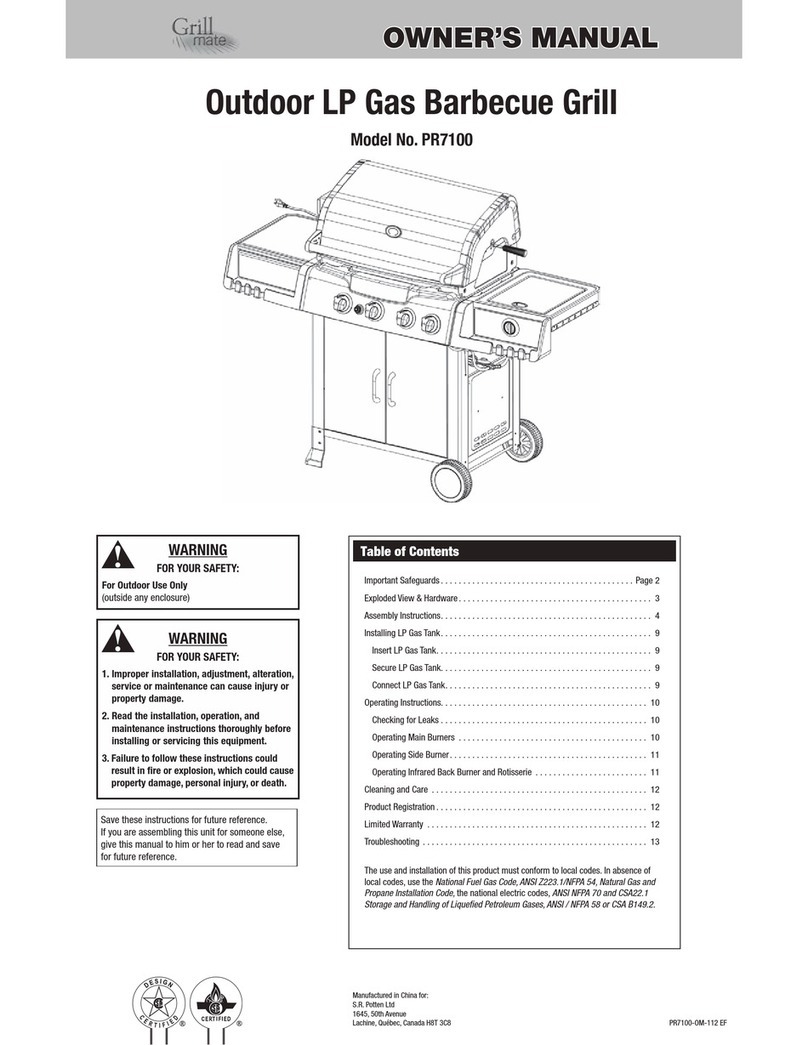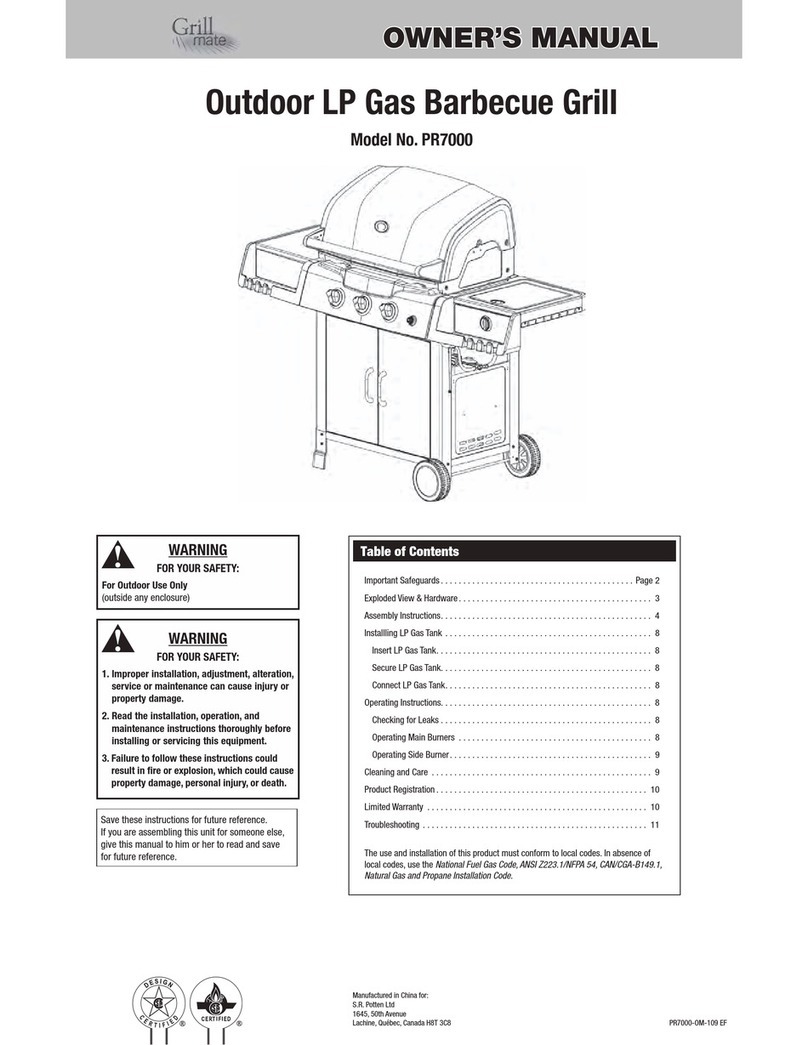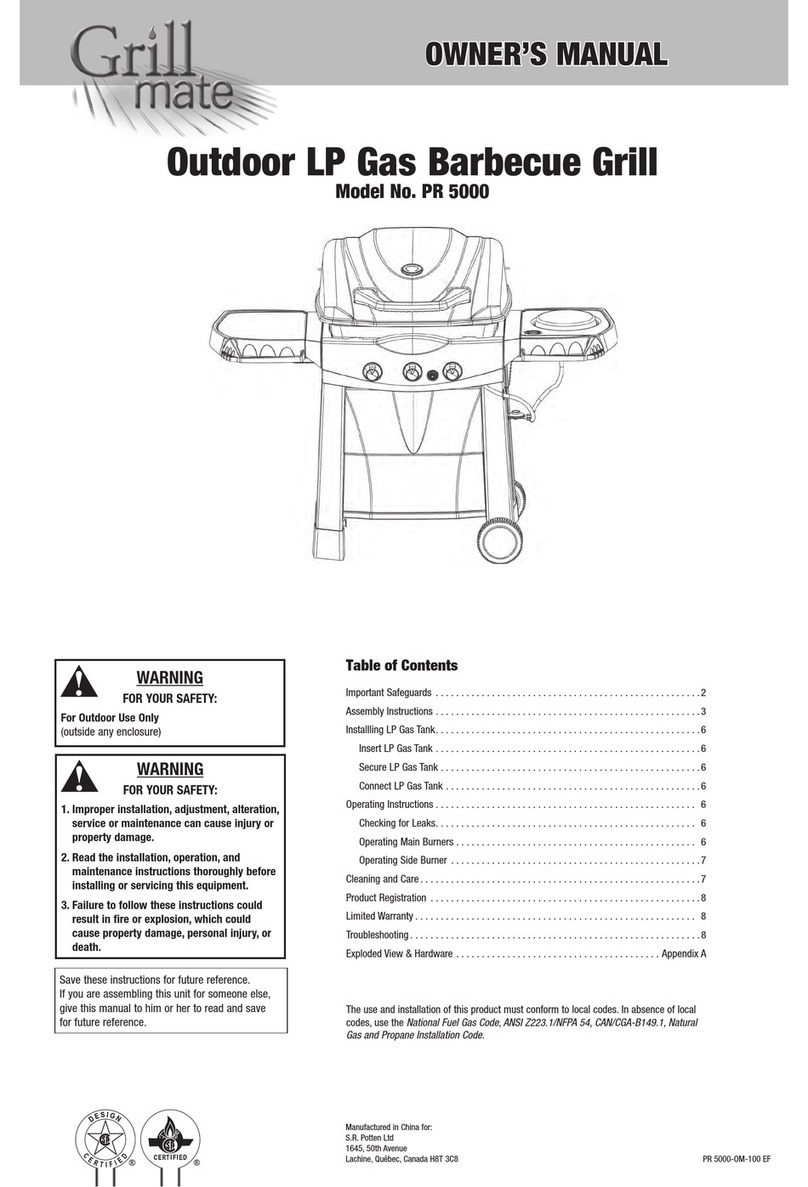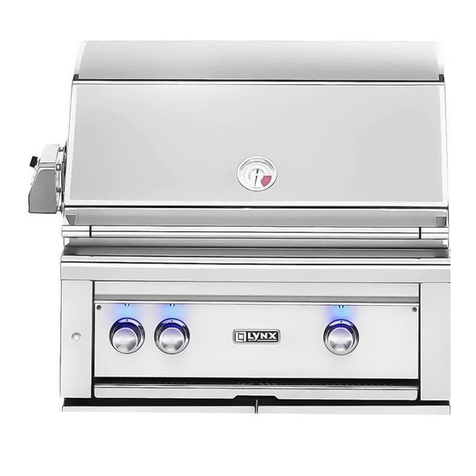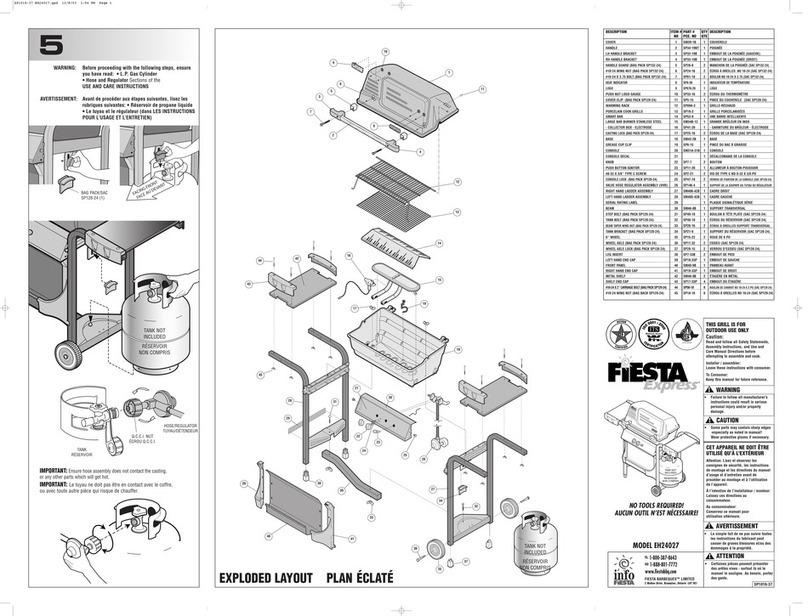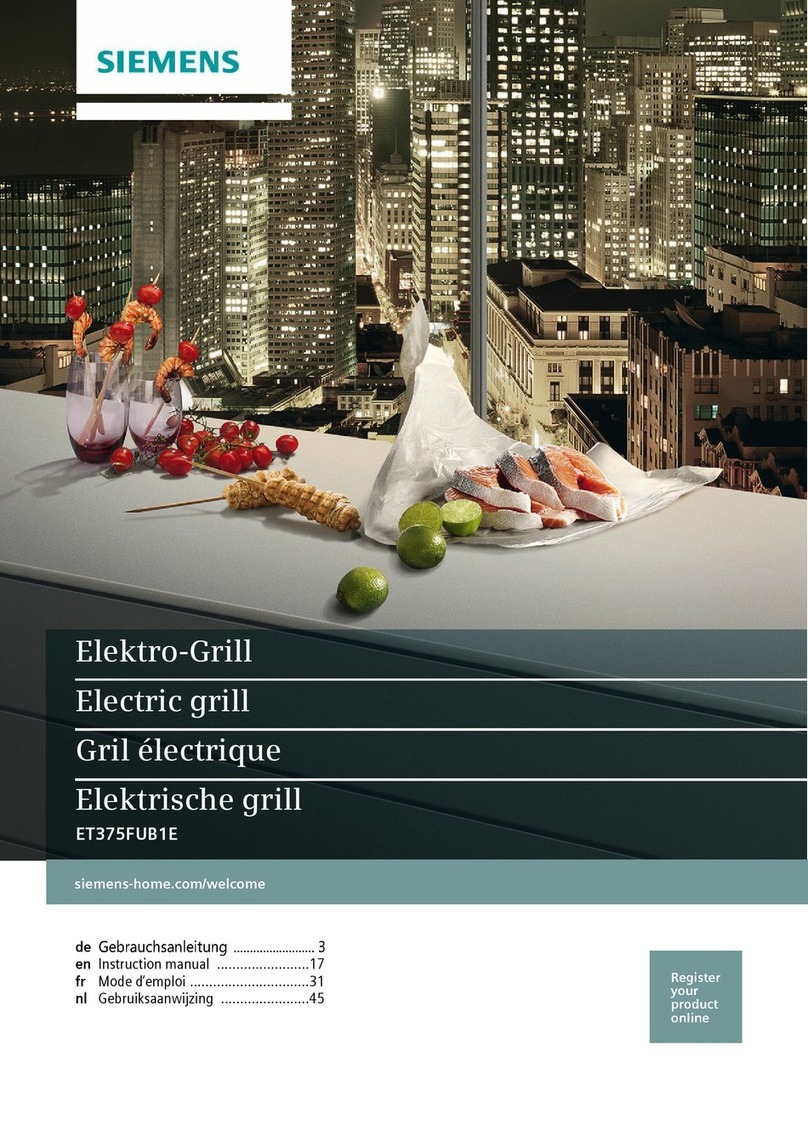Grill Mate PR4400 User manual



Contact 1.800.667.7313 for assistance. Do not return to place of purchase.
page no.
3
Tools Required for Assembly (Included)
#2 Phillips Head Screwdriver
M10-M5 Wrench
1
4
Parts List
1Warming Rack
2Handle
3Temperature Gauge
4Left Cooking Grid
5Right Cooking Grid
6Lid
7Heat Plate
8Top Hinge
9Bottom Hinge
10 Left Side Shelf
11 Left Side Shelf Support (2)
12 Left Side Shelf Heat Plate
13 Burner
14 Grill Body Assembly
15 Top Grill Body Support (2)
16 Control Knob (3)
17 Igniter
18 QCC Clip
19 Regulator/Hose Assembly
20 Right Side Shelf Assembly
21 Lighting Rod
22 Upper Left Rear Leg
23 Grease Cup
24 Upper Right Rear Leg
25 Grease Cup Support
26 Rear Frame Support
27 Bottom Grill Body Support (2)
28 Top Front Panel
29 Top LP Gas Tank Heat Plate
30 Middle LP Gas Tank Heat Plate
31 Bottom Right Rear Leg
32 Frame Bar
33 Bottom Left Rear Leg
34 Bottom Front Panel
35 LP Gas Tank Retainer Wire
36 Bottom LP Gas Tank Heat Plate
37 Hub Cap (2)
38 Wheel (2)
39 Axle
40 LP Gas Tank Support
41 Bottom Shelf
9
Exploded View
15
Hardware
AScrew M6x16 Zinc Plated Phillips Truss Head 49 pcs
BNut M10 Zinc Plated 2 pcs
CWing Nut M6 Zinc Plated 13 pcs
DWasher ø6.4 Zinc Plated 46 pcs
ELock Washer ø6.4 Zinc Plated 46 pcs
FRubber Spacer ø10.5 x ø17.5 x 6 2 pcs
GBattery AA Battery 1 pc
10
20
22
24
6
23
25
29
28
32
30
31
3
35
27
5
2
7
14
26
34
15
27
36
41
40
37
38
37
38
39
8
19 21
17 18
16
11
12
13
33


Contact 1.800.667.7313 for assistance. Do not return to place of purchase.
page no.
5
• Clear an area large enough to layout all components and hardware.
• When applicable, tighten all hardware connections by hand first. Once the step is completed,
go back and fully tighten all hardware.
• Follow all steps in order to properly assemble your product.
4
Attach Frame Bar and Bottom Grill Body Supports
Ax 10 Dx 10
Ex 10
3
Attach Bottom Shelf
Ax 6 Dx 6
Ex 6
7
Attach Top Grill Body Supports, LP Gas Tank Heat Plate
Assembly and LP Gas Tank Retainer Wire, LP Gas Tank
Support
Ax 2
Cx 2
Dx 2
Ex 2
8
Assemble Left Side Shelf
Ax 6 Dx 6
Ex 6


Contact 1.800.667.7313 for assistance. Do not return to place of purchase.
page no.
7
15
Attach Grease Cup and Grease Cup Support
11
Attach Grill Body Assembly and QCC Clip
Ax 5
Cx 1
Dx 4
Ex 4
12
Insert Battery
Gx 1


Contact 1.800.667.7313 for assistance. Do not return to place of purchase.
page no.
9
Turning Off
1. Turn gas off at LP tank.
2. Turn all control knobs clockwise to the OFF position.
First Use
1. Make sure all labels, packaging and protective films have been removed from the grill.
2. Remove manufacturing oils before cooking on this grill for the first time, by operating the grill
for at least 15 minutes on “HIGH” with the lid closed. This will “heat clean” the internal parts
and dissipate odors.
Direct Cooking
Cooking directly over hot burners. Ideal for searing in juices and food requiring less than 25
minutes of grilling time, such as steaks, hamburgers, hot dogs, chicken parts, vegetables and
fruit.
1. Open lid and ignite the desired amount of burners per lighting instructions in owner’s manual.
2. Close lid and preheat grill on “HIGH”.
3. Wear protective gloves and use long handle tongs to place food onto cooking grids above the
lit burners.
4. Adjust controls to desired temperature.
5. With lid open or closed, cook until desired internal food temperatures are achieved.
6. Turn grill OFF by first closing the valve on the propane tank. Burn off remaining gas in lines by
waiting 15 seconds then turn all burner controls to the OFF position. A “poof” sound is normal
as the last of the LP gas is burned.
Indirect Cooking
Not cooking directly over hot burners. Ideal for slow cooking and foods requiring more than 25
minutes such as most roasts, loins, chops, whole chickens, turkey, fish and baked goods.
1. Open lid and ignite the desired amount of burners per lighting instructions in owner’s manual.
2. Close lid and preheat grill on “HIGH”.
3. Wear protective gloves and use long handle tongs to place food onto cooking grids above the
un-lit burners.
4. Adjust controls to desired temperature.
5. With lid closed, cook until desired internal food temperatures are achieved.
6. Turn grill OFF by first closing the valve on the propane tank. Burn off remaining gas in lines by
waiting 15 seconds then turn all burner controls to the OFF position. A “poof” sound is normal
as the last of the LP gas is burned.
For more tips on indirect cooking please see “Tips for Better Cookouts and Longer Grill Life”
Tips for Better Cookouts and Longer Grill Life
1. Use the upper cooking grid (warming rack) for keeping cooked food warm, toasting breads or
cooking delicate foods in aluminum foil pouches.
2. Use the side burner of this appliance like a normal kitchen range for boiling, sautéing or frying.
3. To keep food from sticking to the grids, spray or coat with cooking oil before lighting.
4. To reduce flare-up keep grill clean, use lean cuts of meat (or trim fat) and avoid cooking on
very high temperatures.
5. Place delicate foods like fish and vegetables in aluminum foil pouches and indirect cook or
place on upper cooking levels (warming rack).
6. To avoid losing natural juices, use long handled tongs or spatulas instead of forks and turn
foods over just once during cooking.
7. When direct cooking adjust your burners to different levels so foods can be prepared to
different internal temperatures in the same time frame.
8. When in-direct cooking roasts and larger cuts of meat, place meat onto a roasting rack inside
a heavy gauge metal pan. Place pan over the un-lit burners.
9. Try water pans to reduce flare-ups and cook juicer meats. Before starting grill remove cooking
grids and place a heavy duty shallow pan directly on heat plates. Fill half way with water, fruit
juices or other flavored liquids. Replace cooking grids and position food over the loaded pan.
10. Enhance food flavors by using wood chips in smoker boxes or aluminum foil pouches. Follow
the wood manufacturer’s instructions.
11. Rotisseries, grill baskets, vertical poultry holders and other accessories can enhance your
experiences, reduce cooking times and aid in clean-up.
12. Clean cooking grids and racks after every use with a quality grill bush designed for your grid
material. Wear protective gloves and gently remove the build-up while grids are hot.
13. After every use, allow grill to cool. Then protect clean cooking grids with a light coat of
cooking oil, empty grease pan, wipe outside surfaces with a suitable kitchen cleaner and
protect surfaces with a quality cover that is properly fits your grill.
Cleaning and Care
Caution
1. All cleaning and maintenance should
be done when grill is cool and with
the fuel supply disconnected.
2. DO NOT clean any grill part in a self
cleaning oven. The extreme heat will
damage the finish.
Notices
1. This grill should be thoroughly cleaned and
inspected on a regular basis.
2. Abrasive cleaners will damage this product.
3. Never use oven cleaner to clean any part of grill.
4. Do not clean any grill part in a self cleaning oven.
The extreme heat will damage the finish.
Before Each Use:
1. Keep the grill area clean and free from any
combustible materials, gasoline, and other flammable
vapors and liquids.
2. Do not obstruct the flow of the combustion of LP and
the ventilation air.
3. Keep the ventilation opening(s) of the LP gas tank
area free and clear from debris.
4. Visually check the burner flames, to make sure your
grill is working properly.
5. See cleaning instructions below for proper cleaning
instructions.
6. Check and clean the burner/venturi tubes for insects
and insect nests. A clogged tube can lead to a fire
beneath the grill.
Cleaning Surfaces
1. Wipe surfaces clean with mild dishwashing detergent
or baking soda.
2. For stubborn surfaces use a citrus based degreaser
and a nylon scrubbing brush.
3. Rinse clean with water.
Cleaning Main Burner
1. Turn gas off at the control knobs and LP gas tank.
2. Remove cooking grid and heat plates.
3. Remove burner by removing the fasteners securing
the burner to the grill bottom.
4. Lift burner up and away from gas valve orifice.
5. Disconnect wire from spark electrode.
6. Clean inlet (venturi) of burner with small bottle brush
or compressed air.
7. Remove all food residue and dirt on burner surface.
8. Clean any clogged ports with a stiff wire (such as an
opened paper clip)
9. Inspect burner for any damage (cracks or holes). If
damage is found, replace with new burner.
10. Reinstall burner, check to insure that gas valve
orifice is correctly positioned inside burner inlet
(venturi). Also check position of spark electrode.
11. Replace heat plate and cooking grid.
12. Preform leak test.
1-2 in. /
25.4 - 50.8 mm
1-2 in. /
25.4 - 50.8 mm
Normal: Soft blue flames with yellow
tips between 1 in. - 2 in. hight.
Needs Cleaning: Noisy with hard
blue flames.
Has to be cleaned: Wavy with
yellow flames.
Burner Flame Conditions
Use this chart check to see if your
burners need to be cleaned.


Contact 1.800.667.7313 for assistance. Do not return to place of purchase.
page no.
11
Troubleshooting
Problem Possible Cause Prevention/Cure
Burner will not light using ignitor Wires or electrode covered with cooking residue. Clean wire and/or electrode with rubbing alcohol.
Electrode and burners are wet. Wipe dry with cloth.
Electrode cracked or broken - sparks at crack. Replace electrode.
Wire loose or disconnected. Reconnect wire or replace electrode/wire assembly
Wire is shorting (sparking) between ignitor and electrode. Replace ignitor wire/electrode assembly
Bad ignitor. Replace ignitor
Burner will not light with match No gas flow. Check if LP cylinder is empty. If LP cylinder is not empty, refer
to “Sudden drop in gas flow (reduced flame height). If empty,
replace or refill.
Coupling nut and regulator not fully connected. Turning the coupling nut about one-half to three quarters
additional turn until solid stop. Tighten by hand only-do not use
tools.
Obstruction of gas flow. Clear burner tubes. Check for bent or kinked hose.
Disengagement of burner to valve. Reengage burner and valve.
Spider webs or insect nest in venturi. Clean venturi.
Burner ports clogged or blocked. Clean burner ports.
Sudden drop in gas flow or reduced flame height Out of gas. Check for gas in the LP cylinder
Excess flow safety device may have been activated. Turn off knobs, wait 30 seconds and light grill. If flames are still
too low Reset the excessive flow safety device by turning off
knobs and LP cylinder valve. Disconnect regulator. Turn burner
control knobs to HIGH. Wait 1 minute. Turn burner control knobs
off. Reconnect regulator and leak check connections. Turn LP
cylinder valve on slowly, wait 30 seconds and then light grill.
Irregular flame pattern, flame does not run the full length
of burner.
Burner ports are clogged or blocked. Clean burner ports.
Flame is yellow or orange. New burner may have residual manufacturing oils. Burn grill for 15 minutes with the lid closed
Spider webs or insect nest in venturi Clean venturi.
Food residue, grease or seasoning salt on burner. Clean burner.
Poor alignment of valve to burner venturi. Assure burner venturi is properly engaged with valve
Flame blow out High or gusting winds Turn front of grill to face wind or increase flame height to HIGH
setting
Low on LP Gas Replace or refill LP cylinder
Excess flow valve tripped Refer to “Sudden drop in gas flow”
Flare-up Grease buildup. Clean grill.
Excess fat in meat. Trim fat from meat before grilling.
Excessive cooking temperature. Adjust (lower) temperature accordingly.
Persistent grease fire. Grease trapped by food buildup around burner system Turn knobs to OFF. Turn gas off at LP cylinder. Leave lid in
closed position and let fire burn out. After grill cools, remove
and clean all parts.
Flashback (fire in burner tube(s)) Burner and/or burner tubes are blocked Clean burner and/or burner tubes
Inside of lid is peeling-like paint peeling The lid is stainless steel, not paint. Baked on grease buildup has turned to carbon and is flaking
off. Clean thoroughly.

This manual suits for next models
1
Table of contents
Other Grill Mate Grill manuals
Popular Grill manuals by other brands

Kooper
Kooper 5901116 User instructions

CFM
CFM TG560 Assembly and owner's manual

Campingaz
Campingaz 3 Series instructions
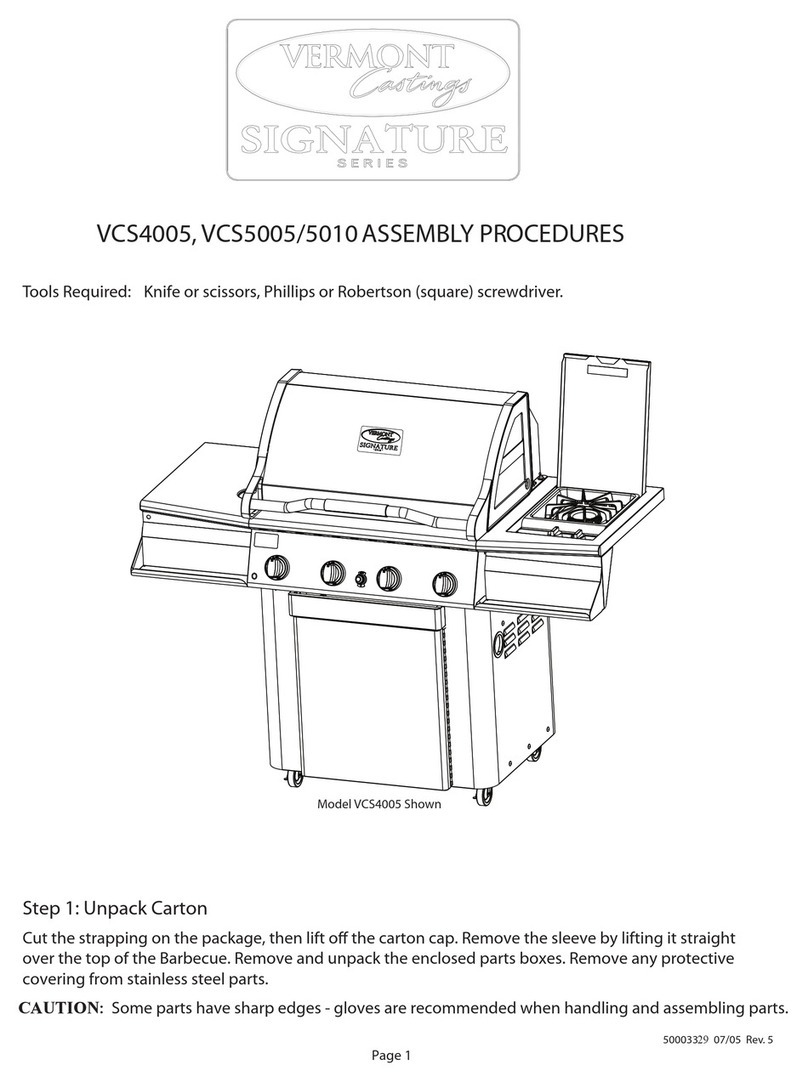
Vermont Castings
Vermont Castings Signature VCS4005 Assembly procedures
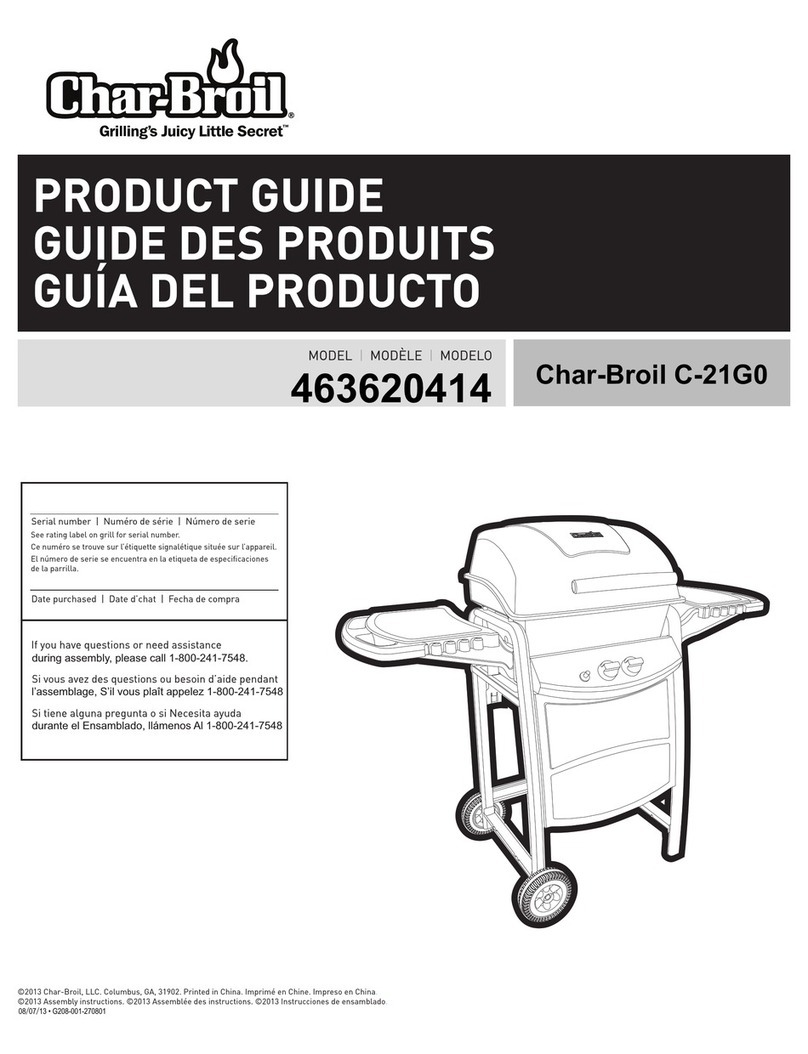
Char-Broil
Char-Broil C-21G0 463620414 Product guide
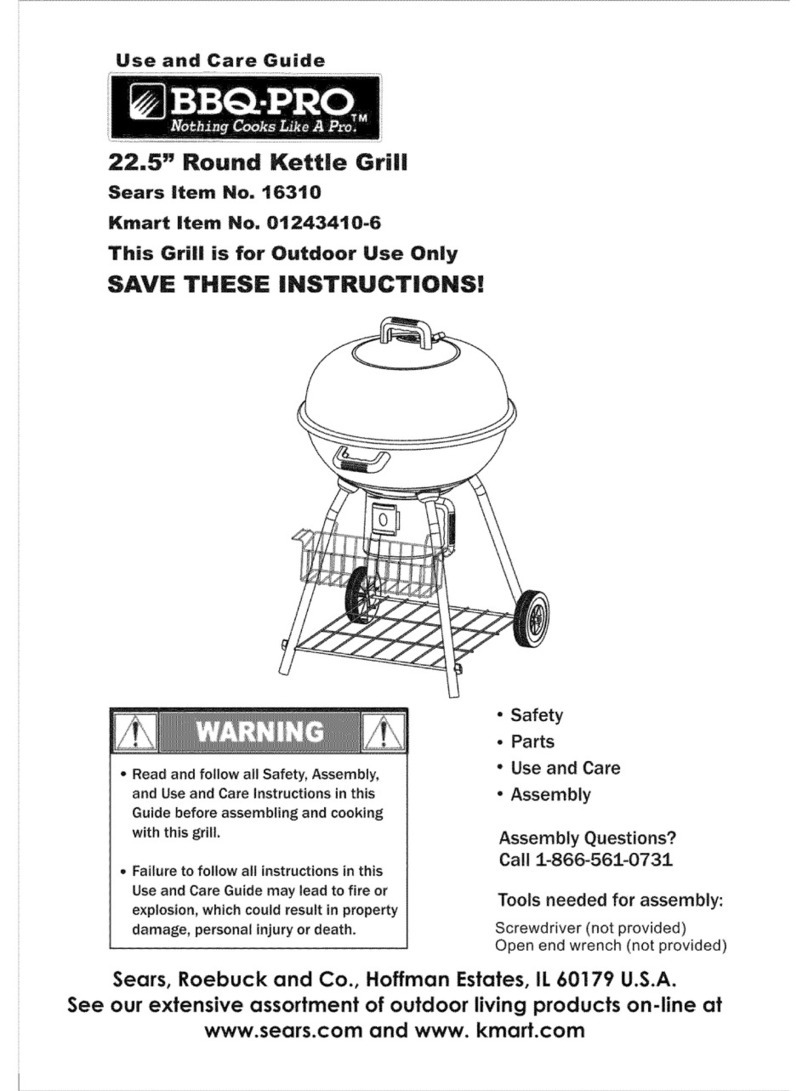
Sears, Roebuck and Co.
Sears, Roebuck and Co. BBQ-Pro 16310 Use and care guide

BURNHARD
BURNHARD BARNEY DELUXE manual

Mayer Barbecue
Mayer Barbecue ZUNDA MGG-102 PRO Assembly instructions
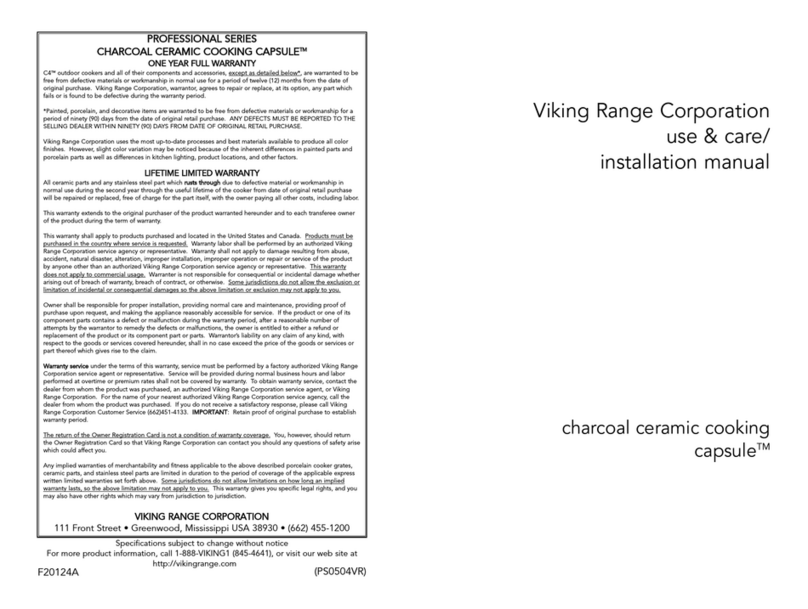
Viking Range
Viking Range C4 Use & care / installation manual

Nexgrill
Nexgrill 1902203 owner's manual

DS Produkte
DS Produkte SW-100MG instruction manual
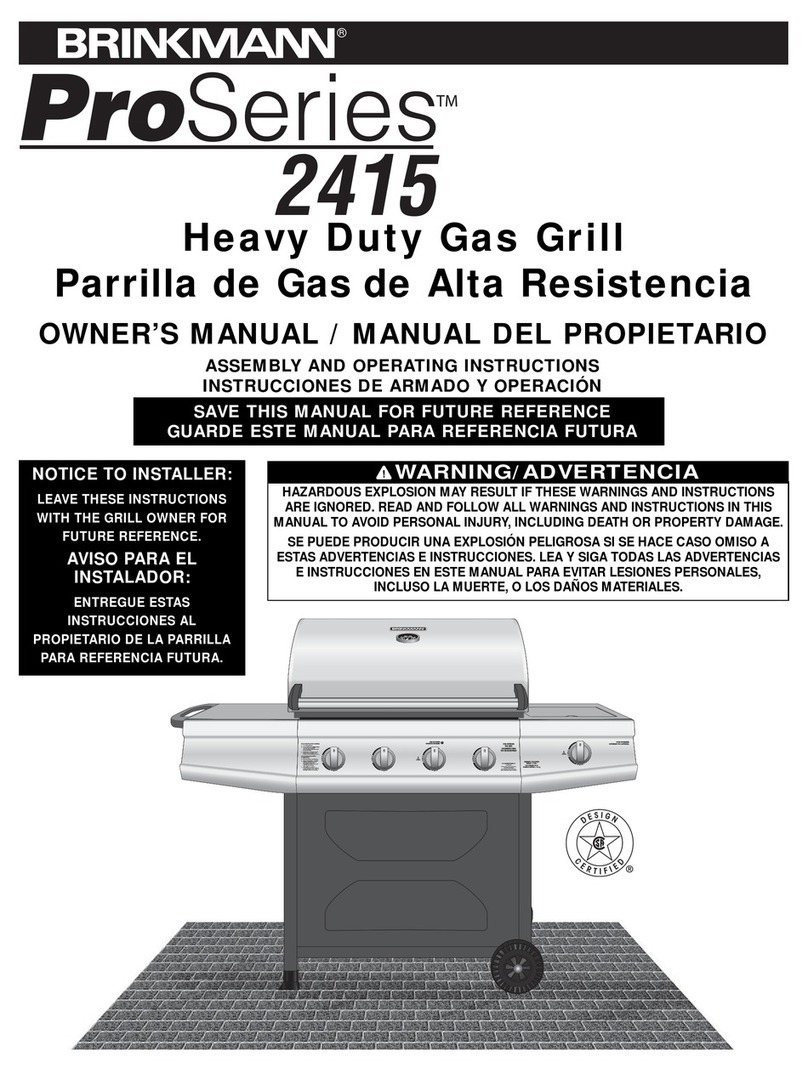
Brinkmann
Brinkmann ProSeries 2415 owner's manual
